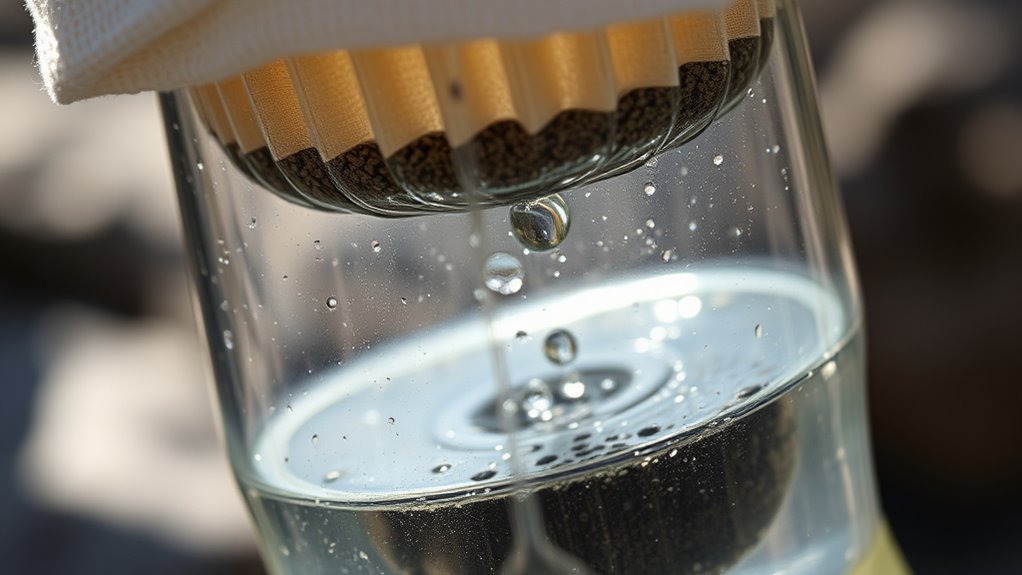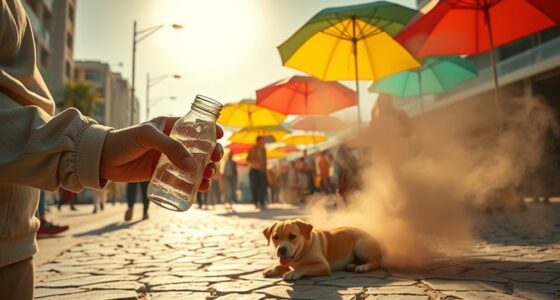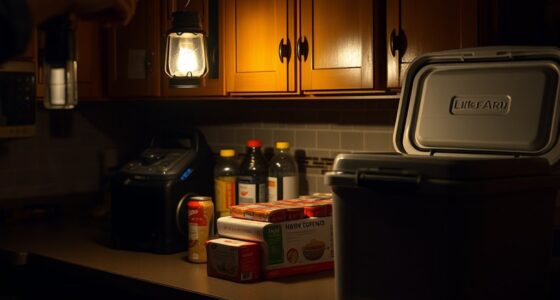In emergencies, you need reliable water purification methods to stay safe. Portable filters quickly remove bacteria, viruses, and sediments, making water clearer and safer to drink. Chemical disinfectants like iodine or chlorine tablets kill remaining pathogens when filtration isn’t possible. Using both filtering and disinfecting together offers the best protection, especially with heavily contaminated water. To learn more about effective techniques and tips, continue exploring how you can guarantee safe drinking water in critical situations.
Key Takeaways
- Portable filtration systems physically remove bacteria, viruses, sediments, and impurities from contaminated water sources.
- Chemical disinfectants like iodine tablets or chlorine drops effectively kill pathogens in heavily polluted water.
- Combining filtration and chemical disinfection provides enhanced safety and ensures removal of both physical and biological contaminants.
- Proper use of chemical disinfectants involves correct dosage and waiting times to guarantee effective pathogen inactivation.
- These methods are practical, quick, and essential for outdoor survival, disaster relief, and emergency water safety.

Water purification methods are essential for guaranteeing safe drinking water, especially in areas where contamination is common. When you’re faced with an emergency situation, having reliable methods like portable filtration and chemical disinfection can make all the difference. Portable filtration systems are compact, easy to carry, and work by physically removing bacteria, viruses, sediments, and other impurities from water sources. These systems often feature activated carbon filters or microfiltration membranes, which improve water clarity and taste while considerably reducing harmful contaminants. Using a portable filter is straightforward—you simply pour water through the device, and it does the heavy lifting for you, guaranteeing you get cleaner water quickly and efficiently.
Chemical disinfection, on the other hand, involves adding disinfectants like iodine tablets, chlorine drops, or household bleach to contaminated water. This method is especially useful when there’s no access to filtration devices or when you’re dealing with heavily polluted water. Chemical disinfection works by killing or inactivating pathogens, making the water safe to drink. It’s important to follow the instructions carefully—using the correct dosage and waiting the required time—to ensure effectiveness. For instance, adding a few drops of household bleach and waiting 30 minutes can eliminate many germs, but you must be cautious not to overdo it, as excessive chemicals can be harmful or affect the taste.
Combining portable filtration with chemical disinfection provides an even higher level of safety. First, you filter the water to remove physical impurities and reduce the concentration of chemicals needed for disinfection. Then, you apply a disinfectant to ensure any remaining microorganisms are eliminated. This two-step approach is particularly valuable in emergency scenarios where water sources are highly contaminated. It allows you to maximize safety with minimal equipment, making it ideal for survival situations, outdoor adventures, or disaster relief efforts.
Frequently Asked Questions
Can Boiling Water Remove Chemical Contaminants?
Boiling water cannot effectively remove chemical contaminants because boiling mainly kills pathogens and eliminates biological impurities. It has limitations in chemical removal, as many chemicals, like pesticides or heavy metals, are not affected by heat. If you’re concerned about chemical contaminants, you should consider additional purification methods such as activated carbon filters or chemical treatment, since boiling alone won’t make chemically contaminated water safe to drink.
How Long Should Water Be Boiled to Ensure Safety?
You should boil water for at least one minute to meet safety standards, guaranteeing it’s safe to drink. If you’re at higher altitudes above 6,562 feet, increase the boiling duration to three minutes. This extended boiling time helps eliminate bacteria, viruses, and parasites effectively. Always follow these guidelines to ensure your water is properly purified and safe for consumption during emergencies.
Are Portable Water Filters Effective Against Viruses?
Imagine your portable water filter as a superhero cape, shielding you from unseen dangers. While they excel at removing bacteria and protozoa, portable water filters often struggle with viral filtration, making them less effective against viruses. You should know that relying solely on these filters isn’t enough for virus protection. For full safety, combine filtration with boiling or chemical treatments, ensuring your water is truly safe to drink.
What Are Natural Methods to Purify Water in Emergencies?
In emergencies, you can use natural methods like rainwater harvesting and solar distillation to purify water. Rainwater harvesting collects clean rainwater, which you can filter further if needed. Solar distillation uses sunlight to evaporate contaminated water and condense it into pure water, removing toxins and pathogens. These methods are simple, effective, and rely on natural resources, making them excellent options when conventional purification systems aren’t available.
How Can I Test Water Quality Before Purification?
You need to test your water quickly to avoid surprises. Use water testing kits, which are simple and portable, to check for contamination indicators like bacteria, chemicals, or pH imbalance. Carefully follow the instructions to get accurate results. Spotting signs of contamination early lets you decide if purification is necessary, ensuring your water is safe to drink and preventing potential health risks in emergencies.
Conclusion
When emergencies strike, think of water purification as your lifeline in a sea of uncertainty. Whether boiling, filtering, or using chemicals, these methods are your trusty anchors amid chaos. Remember, clean water is your most valuable resource—without it, survival becomes a sinking ship. So, stay prepared and know your options; your health depends on it. Stay vigilant, and let safe water be the beacon guiding you through any crisis.










